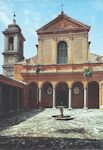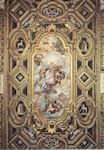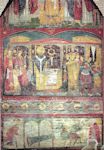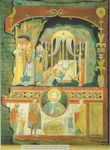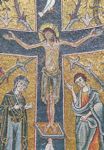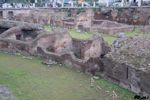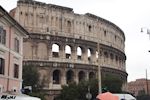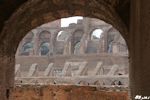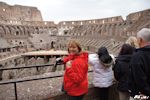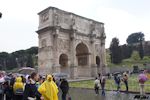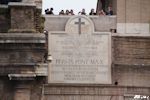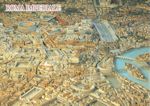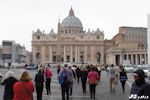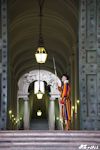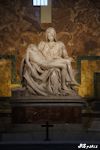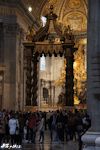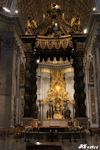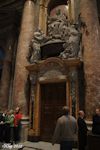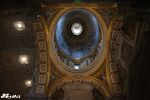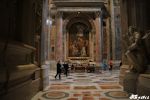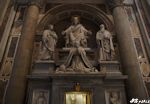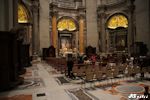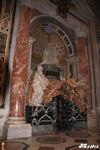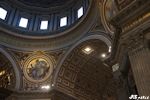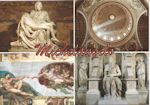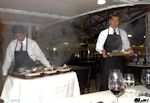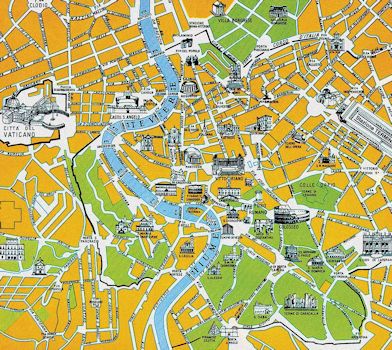Mediterranean Cruise 2012 |
|
|||||||||||||||||||||||||||||||||||||||||||||||||||||||||||||||||||||||||||||||||||||
Links to Port Pages
|
Rome, ITALY Monday, 19 March We arrived at the port in Civitavecchia early in the morning. The morning dawned overcast and misty and would remain so throughout the day. After breakfast we headed out to the port terminal and boarded the bus for our day long tour in Rome. After about an hour and a half we were in the city and nearing the Basilica of San Clemente, our first stop. We were not allowed to take pictures so we actually forgot about seeing this church until we went through all of our Rome information, pictures and then found the postcards we purchased at the basilica! The basilica is very unique in that the present day church was built upon ruins of two previous churches and a private home that had been a secret meeting place for Christians in the first century. The mosaics and early medieval wall paintings are definately not to be missed. The website states the following:
The website for the basilica has lots of information and an excellent video about the church and its history. We highly recommend you go to this link and learn more. Basilica San Clemente . Below are some postcards from the basilica.
We re-boarded the bus and headed towards the Colosseum. We drove by the Basilica di San Paolo (Saint Paul) or "Basilica of Saint Paul Outside the Walls". The basilica is one of Rome's four ancient major basilicas and was founded by the Roman Emperor Constantine I over the burial place of Saint Paul, where it was said that, after the Apostle's execution, his followers erected a memorial, called a cella memoriae. Here's a link to Wikipedia with more information about the basilica. Basilica di San Paolo. This is a place we wished we had stopped and visited. Let's put it on the "Next time we go to Rome" list!
We drove a bit further and finally caught our first glimpse of the Colosseum. The bus had to park in an arranged area above the sites and we walked down the hill to street level. As we got closer to the Colosseum, or actually the Flavian Amphitheater as it is correctly named, we passed by the remains of the gladiator's school. When you see pictures on TV, or in books, you know that it is a massive structure. But walking through the narrow streets lined with buildings and then seeing it rise at the end of the street isa phenomenal experience. We entered into the Colisseum and walked up the ramps to the upper tiers. You can easily imagine the seats and awnings. You can still see marble in places.
Here is a video we shot inside the Colosseum
After exploring through the Colosseum we headed to the Forum. It is amazing to think about the past and that you are walking on the same path many people have walked throughout the centuries. Studying and reading about the history and then being on the same ground where it all happened. At the time, we really did not take in everything we were seeing. As we walked the Forum it was hard to know what exactly what building we were seeing. It would have been helpful to have a map. And we only spent about an hour or less moving through so it was a rather intense "take picture now, figure it out later" experience. But by studying one of the books we bought which shows the "Then and Now" views through the use of color overlays we've had the opportunity to look at our pictures and now they make sense. Below is a slide show of photos from the Colosseum and through the Forum.
We boarded the bus again about 1:00 or 1:30 and headed to a hotel for lunch. We were not overwhelmed by the location nor the food. The meal was served family style of what we would consider Americanized Italian pasta and entrees. Fortunately we did not spend much time here and frankly we can't tell you the hotel we were at for the lunch. Only that it was a few doors down from the Hard Rock Cafe Rome! We would have had a better meal in there. Anyway... Off to Vatican City. We traveled over the Tiber River on the Ponte Vittori (bridge) with a great view of Castel Sant'Angelo. The site is actually Hadrian's Mausoleum and a major feature location in the book and movie "Angels and Demons" by Dan Brown. This is another site on our "Next Time in Rome" list! The bus dropped us off fairly close to St Peter's Square. The walk to the square and the basilica is awe-inspiring. As with many of the other places we visited (and would visit later), the scale and detail of the architecture can't really be photographed accurately. Unfortunately for us, the day we visited was St Joseph's day, so the Sistine Chapel was not open for viewing. (Yep - "Next Time list") However, the basilica needs nearly a whole afternoon, or a day, just to see all the chapels, tombs, memorials, mosaics, and sculptures. We did spend at least an hour wandering through at our own pace as our guide could not come with us and provide commentary, again, due to the holiday. We met back up with the guide outside, and then did a little shopping in a shop owned by the church and recommended by the guide. Below is a video we put together and then there are some of our still photos.
After our time at the Vatican City we started back through the city and headed back to the port. It was a long day, but worth it! We returned to the ship about 7:30 pm and noticed that they had the grill set up on the pool deck for lava rock dining! We are all in for that, no changing clothes, just find a table, get a blanket (as it was fairly cool), and start with a nice relaxing drink. The meal was fabulous! We only enjoyed the grill one evening, but definately could have done that again!
After a long, wonderful day, great meal, and lots of fresh air, we headed to our cabins to rest up for the next day's adventure - Naples is the port, Pompeii is our destination!
Postings before the Trip:
We are scheduled to arrive at the port in Civitavecchia, Italy Monday morning, 19 March 2012 at 7:00 am.
From Wikipedia - "Rome is the capital of Italy and the country's largest and most populated city and comune, with over 2.7 million residents in 1,285.3 km2 (496.3 sq mi). The city is located in the central-western portion of the Italian Peninsula, on the Tiber River within the Lazio region of Italy. Rome's history spans two and a half thousand years. It was the capital city of the Roman Kingdom, the Roman Republic and the Roman Empire, which was the dominant power in Western Europe and the lands bordering the Mediterranean for over seven hundred years from the 1st century BC until the 7th century AD. Since the 1st century AD Rome has been the seat of the Papacy and, after the end of Byzantine domination, in the 8th century it became the capital of the Papal States, which lasted until 1870. In 1871 Rome became the capital of the Kingdom of Italy, and in 1946 that of the Italian Republic. After the Middle Ages, Rome was ruled by popes such as Alexander VI and Leo X, who transformed the city into one of the major centers of the Italian Renaissance, along with Florence. The current version of St Peter's Basilica was built and the Sistine Chapel was painted by Michelangelo. Famous artists and architects, such as Bramante, Bernini and Raphael resided for some time in Rome, contributing to its Renaissance and Baroque architecture. The city is one of Europe's and the world's most successful city "brands", both in terms of reputation and assets. Its historic centre is listed by UNESCO as a World Heritage Site. Monuments and museums such as the Vatican Museums and the Colosseum are amongst the world's 50 most visited tourist destinations (the Vatican Museums receiving 4.2 million tourists and the Colosseum receiving 4 million tourists every year)."
Update 22 January 2012: We scheduled an extraordinary excursion for our day in Rome. This tour affords us the opportunity to see both parts of Rome - ancient and the Vatican, or at least St Peter's! From the Silversea Website Tour List - "Ancient Rome and St Peter's Basilica 19 Mar 2012 | 10.5 Hours | Morning Spend a day exploring the heart of the Roman-Catholic religion during this picturesque and memorable orientation tour of Rome and Vatican City. Basilica of St. Clemente Depart the pier for the scenic, approximately 1.5-hour drive to Rome. Upon arrival, leave the parking area and walk to the entrance of the nearby St. Clemente Basilica. Built in 385 A.D. and destroyed in 1084 by the Normans, the Basilica was rebuilt in 1108. Take a guided tour of the church and its three underground levels representing the various centuries of the Roman Empire. Admire the 4th-century Basilica with its frescoes, the Clemente's House Church of Apostolic times with the Mithraic Area dedicated to the Persian god Mitra and the imposing triumphal Arch of Titus, built in 81 A.D. Roman Colosseum Next, walk to the Colosseum. A longstanding symbol of the greatness of Rome, the Colosseum is among the world's most celebrated monuments. Centuries ago, ancient Romans flocked here to witness gladiatorial contests and other spectacles. The Colosseum was completed around 80 A.D. It featured 76 numbered entrances, marble seating for 80,000 spectators, and subterranean passages where animals and equipment were kept. The arena floor was frequently flooded to host naval combats. Some free time is made available during your visit for photo opportunities. Roman Forum, Arch of Constantine & Lunch The Roman Forum is known as the heart of ancient Rome, where the creation of the Roman civilisation is reflected in the vast ensemble of ruins. Walk through Sacred Way, or 'Via Sacra', the route followed by religious and triumphal processions, and see the impressive Arch of Constantine. From here, walk to Colle Oppio and re-board your coach for the drive to a first-class restaurant or hotel for lunch served with Italian champagne and house wine. After lunch, re-board your coach for the brief drive to Vatican City. St. Peter's Square & St. Peter's Basilica Upon arrival at the parking area, walk to St. Peter's Square for a visit to St. Peter's Basilica. Resting on 800 pillars and highlighted by 44 altars, St. Peter's Basilica is the largest church in the world and Christendom's most magnificent church. Its history dates back to 319 A.D., when the original church was built over the site of the tomb of St. Peter. Reconstruction began in the 15th century and over the ensuing 200 years, Renaissance masters that included Bramante, Raphael, Michelangelo and Bernini worked on its design to create an unparalleled masterpiece. Among the many fine pieces of art on display are Michelangelo's Pietà and immense dome, and the beautifully carved Bernini Pulpit, the bronze canopy over the high altar. Following your visit, some free time is made available for shopping and exploring the area at your leisure. At the conclusion of your visit, return to the parking area and re-board your coach for the approximately 1.5-hour drive back to the pier."
|
||||||||||||||||||||||||||||||||||||||||||||||||||||||||||||||||||||||||||||||||||||
|
|||||||||||||||||||||||||||||||||||||||||||||||||||||||||||||||||||||||||||||||||||||



